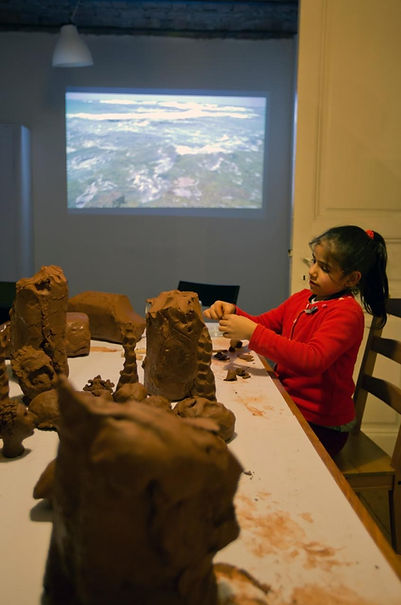Halep
2011 -
2013
© 2035 by The Clinic. Powered and secured by Wix
PASAJTarlabaşı programı
Geçmiş
local a.
soru
the question

©Photo Credit: Local A.
Jenny Berntsson ve Felice Hapetzeder Local A.’de beraber çalışan iki sanatçıdır. Local A.’de genellikle birçok kişinin katıldığı atölyeler üzerinden projeler üretilmektedir. Bu atölyelerde katılımcılar sanat eseri üretim sürecinde yer alırlar, ve daha sonrasında sanatçılar bu sürece ortak olurlar. Local A. bu süreci araştırma atölyeleri olarak tanımlamaktadır.
Bu yeni projesinde Local A. atölye metodunu bir adım öteye taşımak için araştırma atölyelerin kendisinin bir sanat eseri haline gelmesini amaçlıyor. “Performans” terimi yaratıcılığın altını çizen bir ifade olarak kullanıldı. Farklı mekanlarda gerçekleşen atölye süreci yerleştirmelerde kullanılmak üzere kaydedildi. “Soru”’da katılımcılar çamurdan kendi portrelerini yaratmak için eğitim aldılar ve bu süreç de kayıt altına alındı.
Bu şekilde ortaya çıkan katılımcıların yaptığı kendi portreleri bireylerin iletişiminde rol alabilir ya da toplumda bir iz bırakabilir. Yıkıcı unsurlar da içeren bütünün yaratıcı sürecine referans olarak, performans sonunda katılımcılar portrelerini tekrardan söktü.
Performansta ayrıca bir bölüm olarak; katılımcılar bir soru soruyor ve yazılı bir cevap bekleniyor. Sorulan sorular bir önceki performans katılımcıları tarafından soruluyor ve yeni sorular da bir sonraki performans katılımcılarına iletiliyor. Daha önce sadece performans olarak organize edilen “soru” projesinde, bu, sergi formatındaki ilk şov olacak.
“Soru” laspis proje alanı Stokholm’de, Gävle Konstcentrum, Gävle’de, Jerusalem’de ve Hofit sahili İsrail’de gerçekleştirilmiş ve belgelenmiştir. “Soru“ Gavle Konsthall’de video olarak 2015 Baharında gösterilecektir. PASAJ ile gerçekleşecek olan sergide, bu metinler sanatçı ve yazar Camilla Ericson tarafından anonim olarak ve işin sunumunu besleyecek şekilde işe adapte edilmiştir.
The artists Jenny Berntsson and Felice Hapetzeder work together as artist group Local A.Through Local A. they mostly work with art projects involving groups of people in workshops. In these workshops, participants are part of the original creation of artworks, which the artists then continue to elaborate. Local A. calls this process Workshop as Research. In the new project, (the question), Local A. aimed to take the method of Workshop as Research a step further and let the workshops themselves become works of art. The term performance was used to enhance the state of creativity, which was orchestrated. The whole process, performed in different locations, was also filmed to be used in an installation, also containing other elements from the performances.The participants in (the question) are instructed to create self-portraits in clay. This process and the whole setting were filmed. The emerging self-portraits in the public could be seen as a way of displaying the individual’s connection or footprint on society. At the end of the performance participants dismantled the portraits again – a reference to the creative process on the whole, which also contains destructive elements. The performance also has another part, in which the participants are asked to answer one question and pose another in writing. The questions asked are from participants in previous performances and new questions are forwarded to the participants of the next performance. This will be the first show in the exhibition format for (the question), which has previously been played as a performance.
(the question) has been performed and documented at Iaspis Project Space Stockholm, Gävle Konstcentrum in Gävle, the public space in Stockholm, in Jerusalem and at the beach of Hofit in Israel. (the question) will be screened as video work at Gävle Konsthall in spring of 2015.
For the exhibition with PASAJ these texts are used anonymously and fed into the presentation of the work by adaptation by artist and writer Camilla Ericson.

©Photo Credit: Local A.

©Photo Credit: Local A.

©Photo Credit: Local A.

©Photo Credit: Local A.
